A Master Piece Revealed
Conservation Imaging
Updated Jul 20, 2022
Watch the documentary linked and scroll down to learn more about the conservation of the painting.
Bartolomé Esteban Murillo was the first internationally known Spanish artist and this Infant Saint John is one of the earliest to enter a U. S. collection, that of Alfred G. and Matilda Dodge Wilson in 1926.
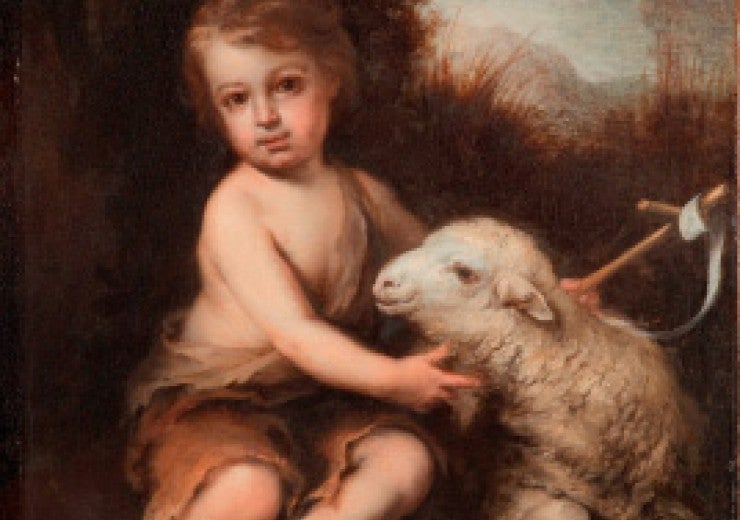
There are no existing records of its previous conservation history. Overall, the condition of the painting is good. It has been lined to a second canvas with a wax-resin adhesive and stretched over a modern, key-able stretcher. This treatment appears to have been carried out sometime in the 1970s. Repainting has been limited to the abraded sky, and a natural resin varnish along with a synthetic varnish have been applied to the surface.
The initial examination of the painting revealed a few changes the artist made to the composition. These changes are called pentimenti. The largest change was only partially visible to the naked having been repainted at some point. This change appears in the right foot of St. John. The leg and foot were extended in the earlier version.
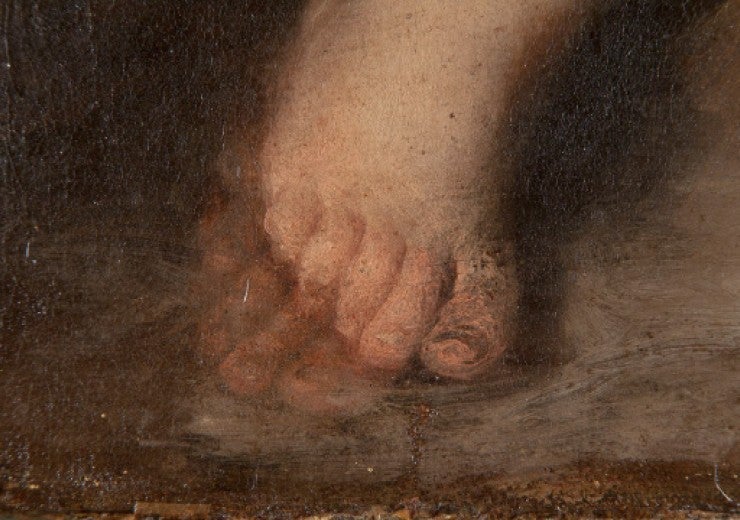
Other, more subtle changes to the composition occur in the index finger and thumb of the right hand and the toes of the left foot.
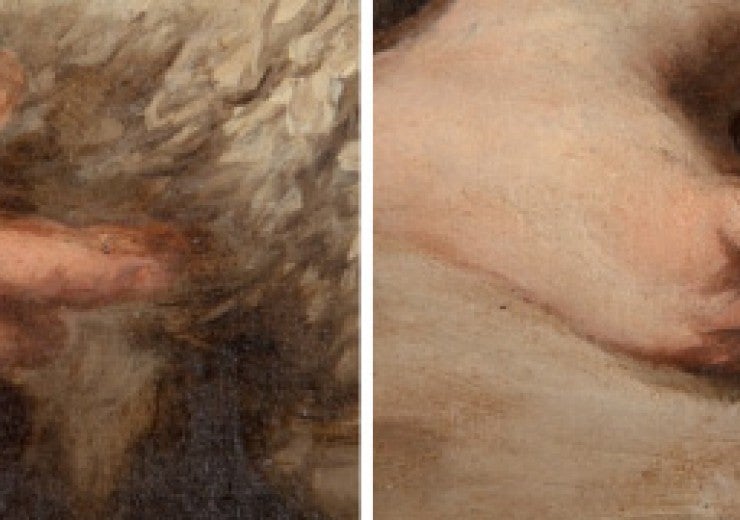
The x-radiograph reveals additional information about painting technique and previous damages to the canvas support. The white lead pigment used in the ground and paint films, as well as other dense metal based pigments, provide us with much information about the brushwork, thickness of the paint film and technical issues, such as tears, or whether the painting has been cut down or reduced in size.

Ultraviolet (UV) fluorescence provides information about coatings and past restorations. In this case, the combination of natural and synthetic varnish layers exhibit a fluorescence with an overall greenish blue tone. The areas of repaint appear as dark brush-marks most visible in the sky and in the pentimenti of the foot and hand.

Visual inspection, X-radiography, and UV imaging of the entire painting are essential to understanding the artist’s technique and the condition of the painting as a whole. However, in order to better understand the pigments used by the artist, scientific analysis is required. Instrumentation in the conservation department is used to conduct analyses that provide information about Murillo’s pigment choices and the method by which he built up the painted surface.
X-ray fluorescence (XRF) spectrometry is one of the analytical tools frequently used. It is non-destructive: it does not damage the painting. XRF provides information regarding the chemical composition of the pigments.
Cobalt, nickel, and arsenic were detected in the XRF analysis of the sky, indicating the use of smalt as the blue pigment. Smalt is a pigment made from finely ground cobalt blue glass and was one of the blue pigments used by painters in the 17th century. The use of smalt in paintings is problematic; smalt eventually loses it blue color, with the fine glass particles becoming grey to colorless. This deterioration explains why the sky in the painting is more grey than blue.
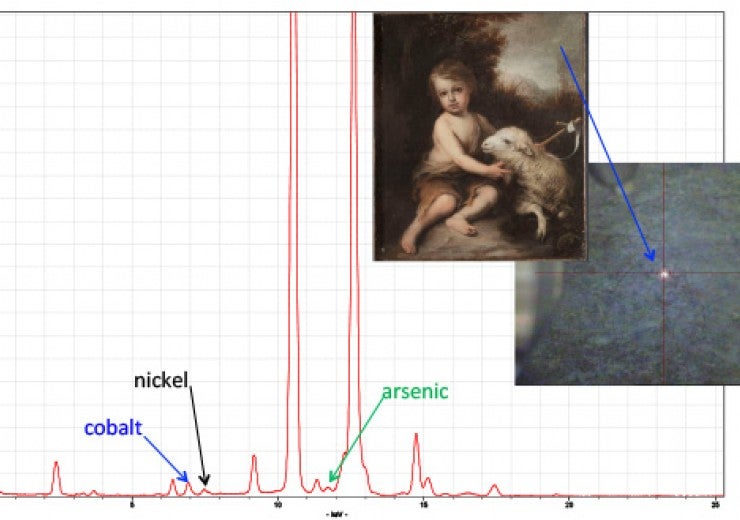
A miniscule sample was removed from the edge of the sky to examine the way Murillo built up the painted surface. The sample is called a cross-section and is used to examine the preparatory and paint layers. A cross-section is so small that it is difficult to see with the naked eye. In fact, it's about the size of a period on a printed page. The cross section is mounted in resin, examined under a microscope, and photographed.
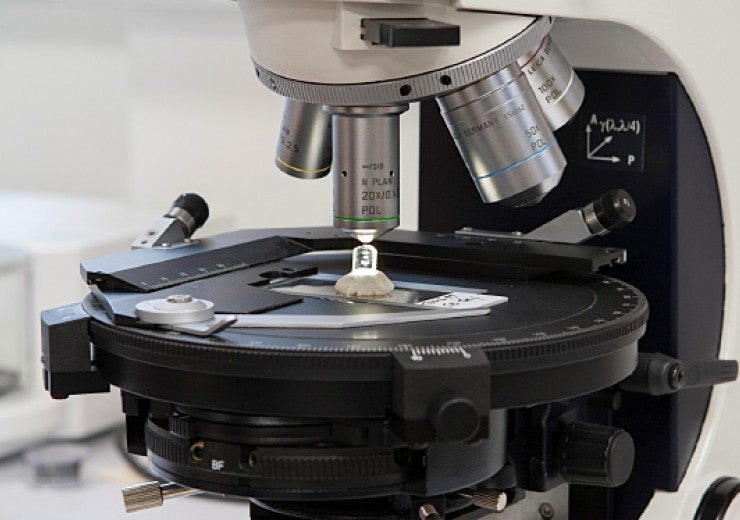
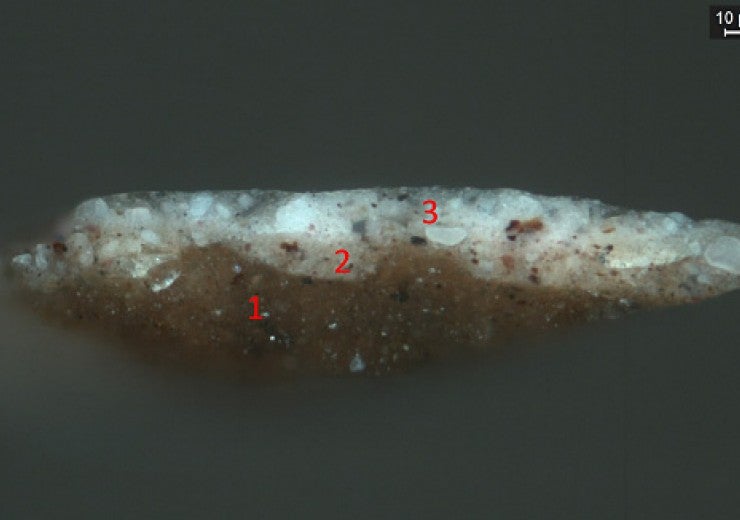
In this photomicrograph of the sky cross-section, there are three layers. Layer 1 is the ground layer, which is applied over the canvas as a preparatory covering. The ground layer is composed of gesso, which is ground gypsum mixed with glue and pigment. Layer 2 is composed of lead white and iron oxide-containing earth pigments. Layer 3, the uppermost one and the visible surface of the painting, contains large particles of lead white and some blue-grey particles to nearly clear smalt particles.
This is how the cross section appears under the microscope with higher magnification, using two types of illumination: normal light (upper image) and UV light (lower image). The UV illumination makes it easier to see the smalt particles. The yellow circles mark the locations of smalt particles, the minute shards of glass. Note that the glass shards are pale blue-grey to nearly colorless.
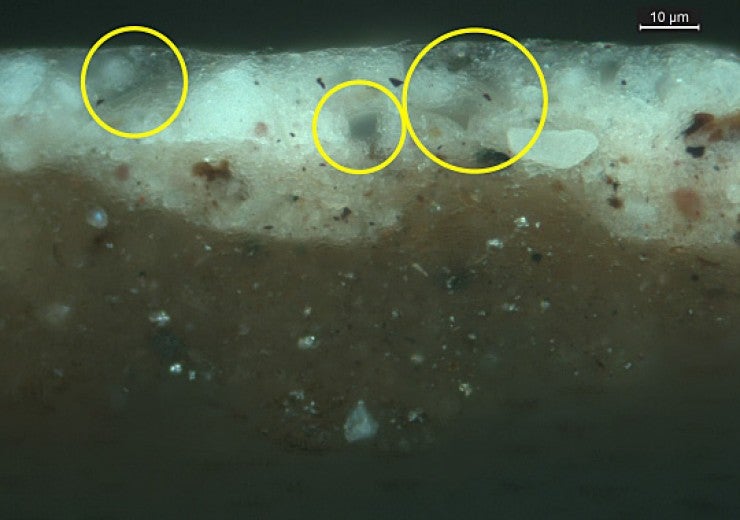
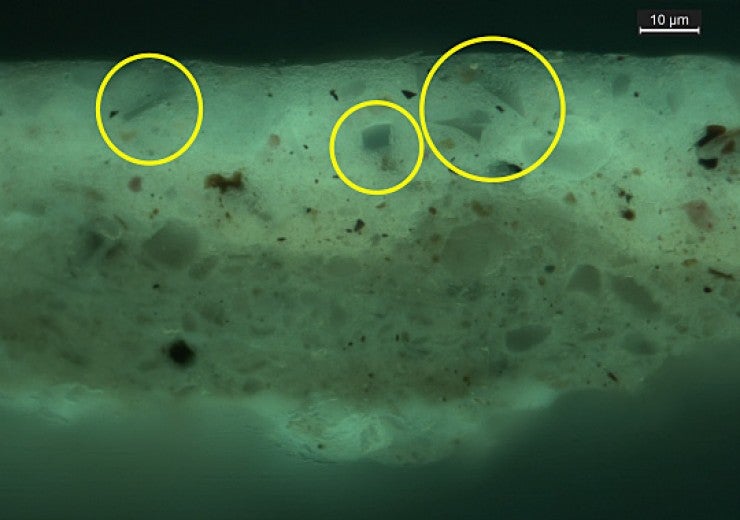
Scientific analysis serves to inform the understanding of the painting and any subsequent treatment by the conservator.
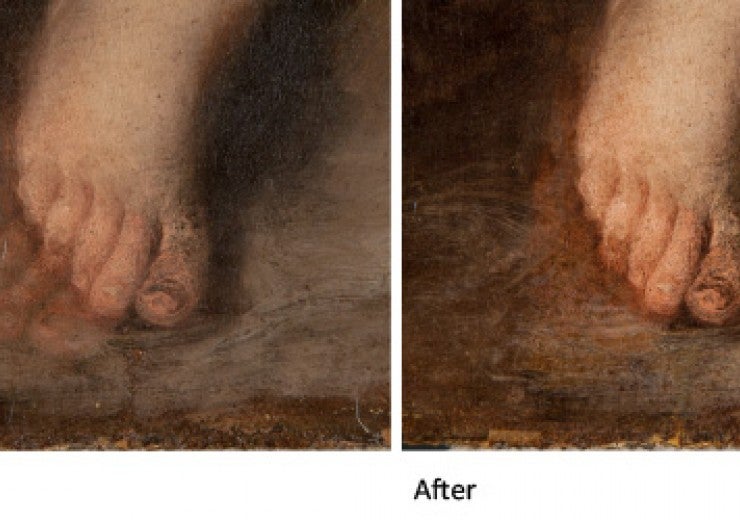
These before and after images show the minimal inpainting used to reduce the distracting effect of the pentimenti. Minimal inpainting was utilized to integrate passages of the damaged blues (smalt) in the sky.
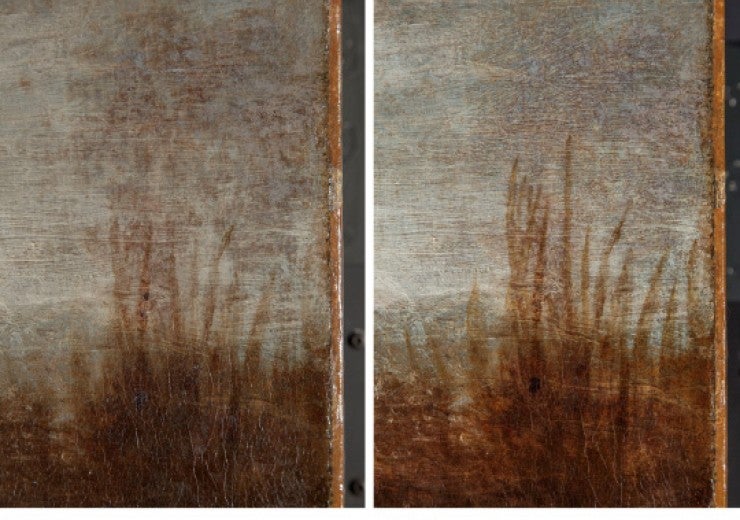
Here is an image of the painting post-treatment, including completed inpainting and the final application of multiple layers of a synthetic varnish, which gives the painted surface a saturated and satin appearance.
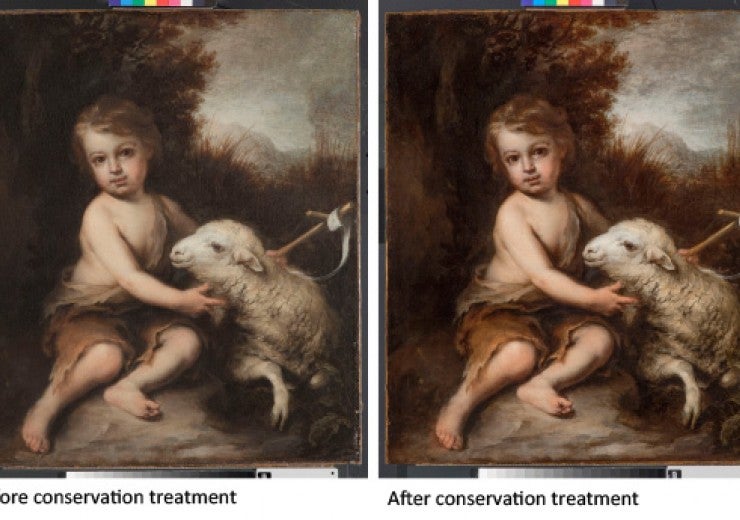
The rediscovery and conservation of Murillo’s The Infant Saint John the Baptist in the Wilderness has proved to not only be a pleasant surprise for DIA staff but also has provided a unique learning experience for Oakland University (OU) students. Because the painting belongs to the Meadow Brook collection, the DIA entered into an agreement with OU to allow a group of undergraduate art history and studio art students to witness the conservation process. This rare opportunity enabled the students to see DIA staff at work and to have at hand unique information produced only in the top museums in the world.
The painting will be on loan to the DIA for five years before returning to Meadow Brook Hall. It will be on view in the DIA’s main European Paintings gallery, beginning February 6, along with two other works by Murillo that the museum owns: The Flight into Egypt and The Immaculate Conception.

scientific instrument
Watch the documentary linked and scroll down to learn more about the conservation of the painting.
Bartolomé Esteban Murillo was the first internationally known Spanish artist and this Infant Saint John is one of the earliest to enter a U. S. collection, that of Alfred G. and Matilda Dodge Wilson in 1926.

There are no existing records of its previous conservation history. Overall, the condition of the painting is good. It has been lined to a second canvas with a wax-resin adhesive and stretched over a modern, key-able stretcher. This treatment appears to have been carried out sometime in the 1970s. Repainting has been limited to the abraded sky, and a natural resin varnish along with a synthetic varnish have been applied to the surface.
The initial examination of the painting revealed a few changes the artist made to the composition. These changes are called pentimenti. The largest change was only partially visible to the naked having been repainted at some point. This change appears in the right foot of St. John. The leg and foot were extended in the earlier version.

Other, more subtle changes to the composition occur in the index finger and thumb of the right hand and the toes of the left foot.

The x-radiograph reveals additional information about painting technique and previous damages to the canvas support. The white lead pigment used in the ground and paint films, as well as other dense metal based pigments, provide us with much information about the brushwork, thickness of the paint film and technical issues, such as tears, or whether the painting has been cut down or reduced in size.

Ultraviolet (UV) fluorescence provides information about coatings and past restorations. In this case, the combination of natural and synthetic varnish layers exhibit a fluorescence with an overall greenish blue tone. The areas of repaint appear as dark brush-marks most visible in the sky and in the pentimenti of the foot and hand.

Visual inspection, X-radiography, and UV imaging of the entire painting are essential to understanding the artist’s technique and the condition of the painting as a whole. However, in order to better understand the pigments used by the artist, scientific analysis is required. Instrumentation in the conservation department is used to conduct analyses that provide information about Murillo’s pigment choices and the method by which he built up the painted surface.
X-ray fluorescence (XRF) spectrometry is one of the analytical tools frequently used. It is non-destructive: it does not damage the painting. XRF provides information regarding the chemical composition of the pigments.
Cobalt, nickel, and arsenic were detected in the XRF analysis of the sky, indicating the use of smalt as the blue pigment. Smalt is a pigment made from finely ground cobalt blue glass and was one of the blue pigments used by painters in the 17th century. The use of smalt in paintings is problematic; smalt eventually loses it blue color, with the fine glass particles becoming grey to colorless. This deterioration explains why the sky in the painting is more grey than blue.

A miniscule sample was removed from the edge of the sky to examine the way Murillo built up the painted surface. The sample is called a cross-section and is used to examine the preparatory and paint layers. A cross-section is so small that it is difficult to see with the naked eye. In fact, it's about the size of a period on a printed page. The cross section is mounted in resin, examined under a microscope, and photographed.


In this photomicrograph of the sky cross-section, there are three layers. Layer 1 is the ground layer, which is applied over the canvas as a preparatory covering. The ground layer is composed of gesso, which is ground gypsum mixed with glue and pigment. Layer 2 is composed of lead white and iron oxide-containing earth pigments. Layer 3, the uppermost one and the visible surface of the painting, contains large particles of lead white and some blue-grey particles to nearly clear smalt particles.
This is how the cross section appears under the microscope with higher magnification, using two types of illumination: normal light (upper image) and UV light (lower image). The UV illumination makes it easier to see the smalt particles. The yellow circles mark the locations of smalt particles, the minute shards of glass. Note that the glass shards are pale blue-grey to nearly colorless.


Scientific analysis serves to inform the understanding of the painting and any subsequent treatment by the conservator.

These before and after images show the minimal inpainting used to reduce the distracting effect of the pentimenti. Minimal inpainting was utilized to integrate passages of the damaged blues (smalt) in the sky.

Here is an image of the painting post-treatment, including completed inpainting and the final application of multiple layers of a synthetic varnish, which gives the painted surface a saturated and satin appearance.

The rediscovery and conservation of Murillo’s The Infant Saint John the Baptist in the Wilderness has proved to not only be a pleasant surprise for DIA staff but also has provided a unique learning experience for Oakland University (OU) students. Because the painting belongs to the Meadow Brook collection, the DIA entered into an agreement with OU to allow a group of undergraduate art history and studio art students to witness the conservation process. This rare opportunity enabled the students to see DIA staff at work and to have at hand unique information produced only in the top museums in the world.
The painting will be on loan to the DIA for five years before returning to Meadow Brook Hall. It will be on view in the DIA’s main European Paintings gallery, beginning February 6, along with two other works by Murillo that the museum owns: The Flight into Egypt and The Immaculate Conception.
A Master Piece Revealed
Conservation Imaging